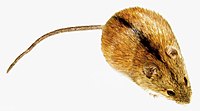
Photo from wikipedia
We livetrapped populations of Microtus montanus from 1982 to 2003 in semiarid perennial old-field grasslands of southern British Columbia. We evaluated two, nonmutually exclusive hypotheses (H) to explain their population… Click to show full abstract
We livetrapped populations of Microtus montanus from 1982 to 2003 in semiarid perennial old-field grasslands of southern British Columbia. We evaluated two, nonmutually exclusive hypotheses (H) to explain their population dynamics: first (H1), that extended breeding during the summer or winter will drive the increase phase of population fluctuations; and second (H2), that density-dependent depression of juvenile survival will be reflected in poor early juvenile survival during high populations. Populations on 2–3 grids of 1 ha were livetrapped at 3- to 8-week intervals in summer and winter except in 5 years of very low populations. Densities ranged from 10/ha to 250/ha. Peak densities occurred in 6 years and an extended low phase occurred from 1999 to 2003. Fluctuations of 3–4 years appeared in our populations but were not always present. Breeding occurred both in summer and winter, and the best predictor of the population growth rate was the fraction of adult females lactating in summer or winter, thereby supporting H1. Juvenile production (number of juveniles/lactating female) varied greatly among years with the mean being over two times higher in low (2.41) than high (1.08) years, thereby supporting H2. There was no clear correlation between population changes and either seasonal temperatures or rainfall, or any combination of these two variables, and no obvious cause of the prolonged low from 1999 to 2003. Thus, both female reproduction and juvenile production drive montane vole dynamics demographically, similar to what is found in other vole species. However, the ultimate cause of these changes remains to be tackled experimentally.
Journal Title: Journal of Mammalogy
Year Published: 2021
Link to full text (if available)
Share on Social Media: Sign Up to like & get
recommendations!